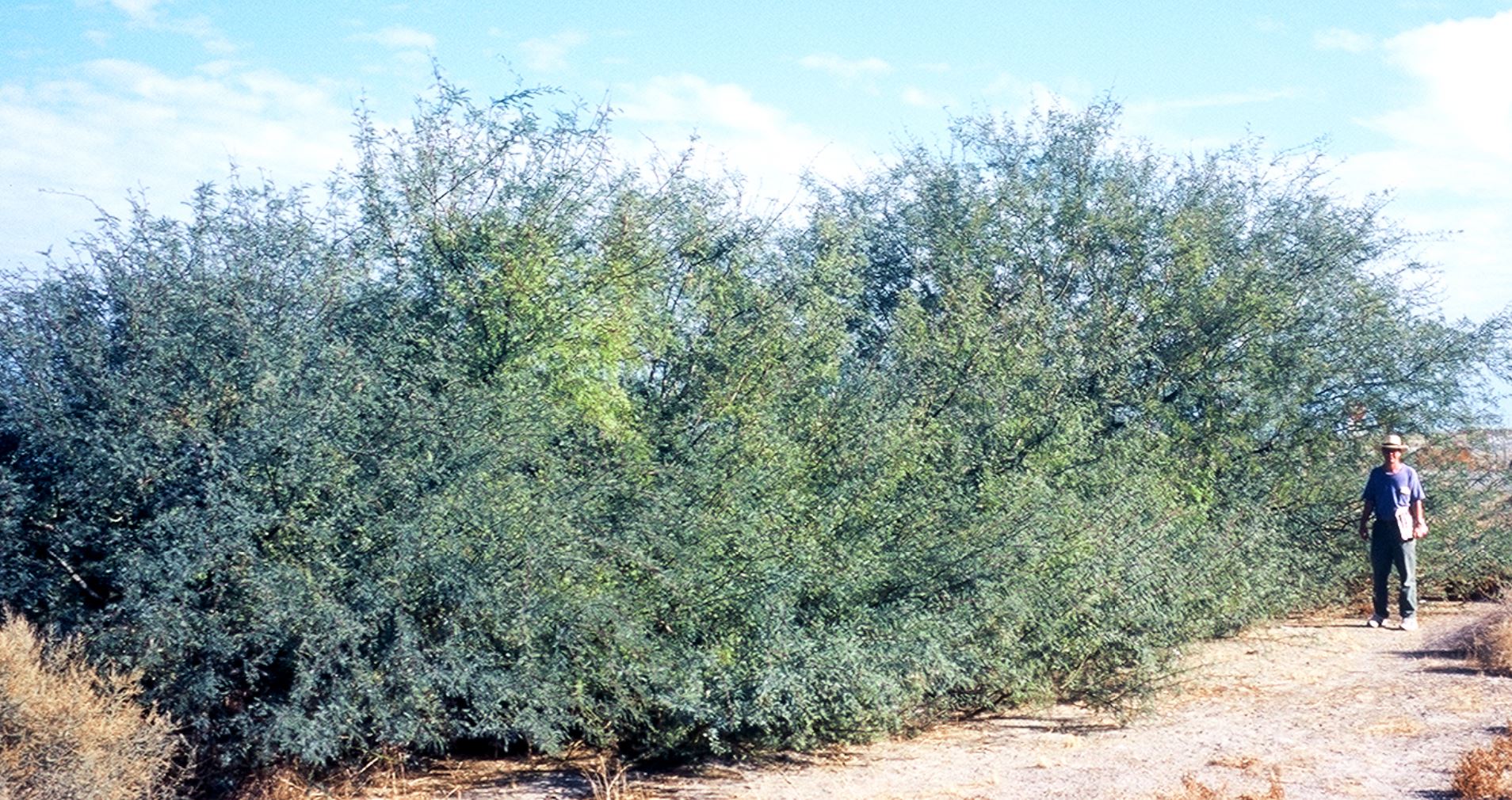Mesquite is a valuable multi-purpose tree crop well suited for agroforestry in the American Southwest (Bainbridge et al. 1990; Felger 1990). The pods are edible (Meyer 1984) and useful for fodder (Silber 1988). Mesquite was a critical food for native people and they planted seeds and transplanted seedlings (Shipek 1989; Bell and Castetter 1937). The flower is a yellow inflorescence with many spikes favored by bees. The hardwood is suitable for many purposes and excellent for charcoal (Bainbridge 1986).
Mesquite is a nitrogen fixer and fixation rates can be high and associated with roots 8 meters deep or more (Jenkins et al. 1987; Virginia et al 1986). Roots have been found at 46 m depth (Phillips 1963). Trees are long-lived and can grow to considerable size. Growth can be rapid with water availability as seen in figure 1. Microcatchments can be used with super-efficient irrigation, but growth will be slow if water availability is limited (Bainbridge 2015). However, mesquite can survive remarkable levels of drought stress and resume growing when it rains. Mesquite trees are also tolerant of fire and resprout readily (Steinberg 2001). These features all make mesquite a good candidate for carbon sequestration in agroforestry settings.
 Figure 1 Rapid growth, P. glandulosa windbreak at 5 years, Coachella Valley, California
Figure 1 Rapid growth, P. glandulosa windbreak at 5 years, Coachella Valley, California
Mesquite is easy to propagate and outplant and grows quickly when water is available. Screwbean mesquite (P. pubescens ) can tolerate relatively high salinity, but does not grow as fast as P. glandulosa. Tree shelters, figure 2, can be critical to reduce seedling herbivory (Bainbridge and Tiszler 2014). Tall containers are preferred to maintain a strong tap root in seedlings (see for example Stuewe and Sons deep pots (stuewe.com) see figure 3 . Direct seeding may also be effective and is inexpensive if adequate soil moisture can be maintained. Seeds must be scarified to allow the seed to germinate. Under favorable conditions mesquite roots can grow rapidly, up to 5 cm in 12 hours (Cannon 1917).
 Figure 2 Herbivory was a persistent problem in the low desert. Mesquite was kept at or near the top of the tree shelter for years
Figure 2 Herbivory was a persistent problem in the low desert. Mesquite was kept at or near the top of the tree shelter for years
 Figure 3 Deep containers are ideal for mesquite, protecting the tap root
Figure 3 Deep containers are ideal for mesquite, protecting the tap root
These factors all make mesquite a good candidate for carbon sequestration in an agroforestry setting. Sequestration of carbon up to 6.6 Mg/ha at 25% canopy cover is reasonable (Geesing et al. 2000). Mesquite can be planted in rows with alley inter-cropping, rows for windbreaks, coppice with standards, or coppice blocks for fuelwood, honey, and pod. Mesquite may play an important role in toxic dust management in areas like the Salton Sea Basin (Iovenko 2015). Mesquite can be an aggressive invader in non-native settings—but comparable locally appropriate nitrogen fixers can usually be found. Geesing et al. (2000) estimated that with effective planting programs agroforestry for semi-arid lands could sequester 6.2 billion metric tons of carbon per year. Much of this could be in agroforestry applications. This is about two thirds of the world’s annual emissions (Jackson et al. 2019).
References
Bainbridge DA (2015) Gardening with Less Water. Storey Press. North Adams, MA.
Bainbridge DA Tiszler JC. (2014) Restoring mesquite mounds (nebkhas) in the Colorado Desert. Rest. Res. Project Note. 29p. https://works.bepress.com/david_a_bainbridge/36/
Bainbridge DA (2012) Use of tree shelters as deep containers. Tree Planter’s Notes. 55(2):50-54.
Bainbridge DA Virginia RA Jarrell WM (1990) Honey mesquite: a multipurpose tree for arid lands. Nitrogen Fixing Tree Association Highlights 90-07, December 2 p.
Bainbridge DA (1986) Mesquite as a fuel wood. Permaculture Activist. (Summer):6-7.
Bell, WH Castetter EF (1937) The utilization of mesquite and screwbean by the aborigines in the American Southwest. Univ. New Mexico Biol. Series 5(2):1-55.
Cannon WA (1917) Relation of the rate of root growth in seedlings of Prosopis velutina to the temperature of the soil. Plant World 20:320-333.
Felger RS (1990) Mesquite: a world food crop. Aridus 2(1):1-3.
Geesing D Felker P Bingham R (2000) Influence of mesquite (Prosopis glandulosa) on soil nitrogen and carbon development: Implications for global carbon sequestration. J Arid Environ. 46: 157-180. 10.1006/jare.2000.0661.
Iovenko C (2015) Toxic dust from a dying California lake. The Atlantic. Nov. 9. https://www.theatlantic.com/science/archive/2015/11/the-airborne-toxic-lake-event/414888/
Jackson RB et al. (2019) Global Energy Growth Is Outpacing Decarbonization. A special report for the United Nations Climate Action Summit September 2019. Global Carbon Project, International Project Office, Canberra Australia.
Jenkins, MB Virginia RA Jarrell WM 1987. Rhizobial ecology of the woody desert legume mesquite (Prosopis glandulosa ) in the Sonoran Desert. Appl. Environ. Microbiol. 55:36-40.
Meyer, D (1984) Processing, utilization, and economics of mesquite pods. Swiss Federal Institute of Technology, Zurich, 159p.
Phillips WS (1963) Depth of roots in soil. Ecology 44:424.
Shipek F (1989) An example of intensive plant husbandry: the Kumeyaay of southern California. In D.R. Harris and G.C. Hillman editors. Foraging and Farming, Unwin Hyman, London, UK pp 159-170
Silber, MS (1988) Mesquite pod utilization for livestock feed: an economic development alternative in Central Mexico. University of Arizona, Thesis.
Steinberg P (2001) Prosopis glandulosa. In: Fire Effects Information System. [Online]. U.S. Department of Agriculture, Forest Service, Rocky Mountain Research Station, Fire Sciences Laboratory (Producer). https://www.fs.fed.us/database/feis/plants/tree/progla/all.html [2020, October 31]. l
Virginia RA Jenkins MB Jarrell WM (1986) Depth of root symbiont occurrence in soil. Biol. Fertil. Soils. 2:127-130.

